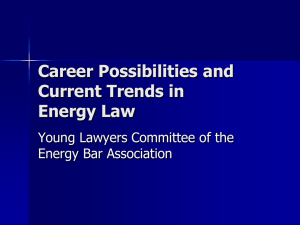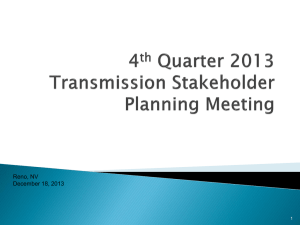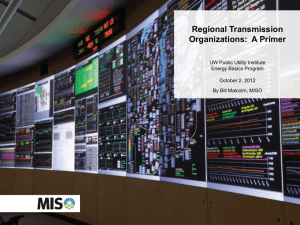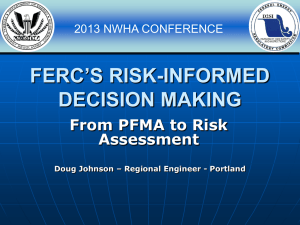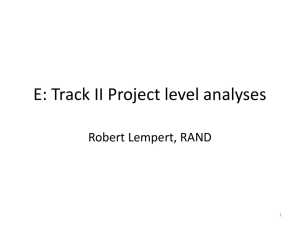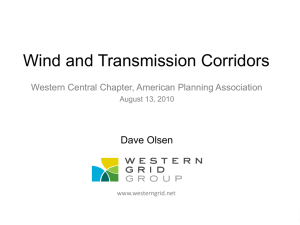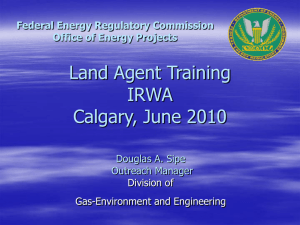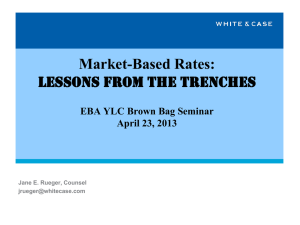Charles Sensiba - Northwest Hydroelectric Association
advertisement
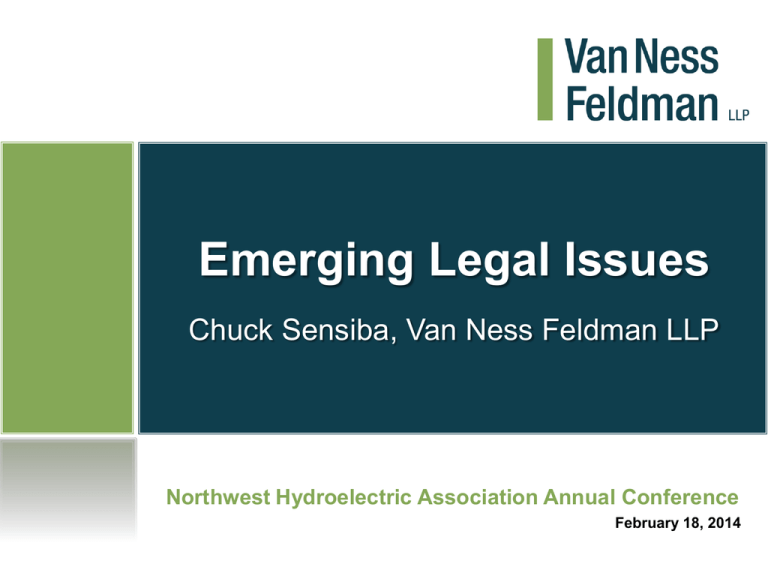
Emerging Legal Issues Chuck Sensiba, Van Ness Feldman LLP Northwest Hydroelectric Association Annual Conference February 18, 2014 Key Cases and Orders Simmons v. Sabine River Authority State of Louisiana, 732 F.3d 469 (5th Cir. 2013) FFP Qualified Hydro 14, LLC, 145 FERC ¶ 61,255 (2013) Power Site Reservation Fees Group, 142 FERC ¶ 61,196 (2013) Simmons v. Sabine River Authority State of Louisiana, 732 F.3d 469 ◘ In October 2013, the Fifth Circuit rules that statelaw tort claims that seek to alter operations of a FERC-licensed hydro project are preempted by the Federal Power Act (FPA). Simmons v. Sabine River Authority State of Louisiana, 732 F.3d 469 ◘ Despite FPA § 10(c), which preserves state law claims for damages inflicted on the property of others, the Fifth Circuit held that state tort laws impeding FERC’s operational control over dam operations are preempted. • Prior FERC proceeding • FERC findings of fact ◘ Plaintiffs filed a Petition for a Writ of Certiorari with the U.S. Supreme Court on January 7, 2014. FFP Qualified Hydro 14, LLC, 145 FERC ¶ 61,255 (2013) ◘ FERC holds that municipal preference under FPA § 7(a) applies only to hydropower projects located in the “vicinity” of the municipality. ◘ Muni should receive preference to develop “nearby hydropower sites” but not in public interest to grant preference for project “far from the site of the municipality.” ◘ Muni in case was located almost 400 miles from the project site – deemed to be outside of vicinity. FFP Qualified Hydro 14, LLC, 145 FERC ¶ 61,255 (2013) ◘ Order ends FERC’s existing practice of applying muni preference to any state or municipal application for preliminary permit or original license without regard to location of project. ◘ Could significantly reduce the use of muni preference in future permitting and licensing decisions. ◘ Rehearing is pending. Project Nos. 13579 and 14491. Power Site Reservation Fees Group, 142 FERC ¶ 61,196 (2013) ◘ FERC holds that it will no longer assess annual charges for non-federal lands at hydropower projects that are subject to a federal power site reservation under FPA § 24. ◘ Changes longstanding FERC policy dating to 1981. ◘ Will result in significant reductions in federal land use annual charges for numerous projects, particularly in Alaska and other areas in the West. Major Policy Initiatives HREA Implementation Columbia River Treaty Renewal Implementation of Hydropower Regulatory Efficiency Act ◘ On August 9, 2013, the President signed into law H.R. 267, the Hydropower Regulatory Efficiency Act of 2013 (HREA). ◘ First energy law passed by Congress in more than 5 years. ◘ Significant update in FERC’s regulation of small hydropower development. Implementation of Hydropower Regulatory Efficiency Act ◘ HREA provisions: • 2-Year Pilot Licensing Process: Mandated FERC to investigate a 2-year licensing process for certain projects • Qualifying Conduit Facilities: Created new class of 5 MW facilities that are excluded from FERC jurisdiction • Extended Preliminary Permit Terms: Authorized FERC to extend by 2 years permit terms at its discretion • Conduit Exemptions: Increased capacity limit (from 15 to 40 MW) for FERC conduit exemptions sought by nonmunicipalities • Small Hydropower Exemptions: Increased the capacity limit (from 5 MW to 10 MW) for small hydro project exemptions Implementation of Hydropower Regulatory Efficiency Act ◘ Two-Year Licensing Process ◘ Eligible projects must: • (1) be located at a non-powered dam or be a closed-loop pump storage project; • (2) cause little to no change to existing surface and groundwater flows and uses; and • (3) be unlikely to adversely affect federally listed threatened and endangered species. ◘ Additional Requirements for some projects: • Located at or will use a federal dam – include a letter from the dam owner that the applicant’s plan of development is conceptually feasible • Use any public park, recreation area, or wildlife refuge established under state or local law – include a letter from the managing entity indicating its approval of the site’s use for hydropower development • Closed-loop pumped storage – not continuously connected to a naturally flowing water feature Implementation of Hydropower Regulatory Efficiency Act ◘ Two-Year Licensing Process ◘ Requests to use the 2-year licensing process must be filed between February 5 – May 5, 2014. ◘ Requests must include: • • • • • An adequate consultation record, Pre-application document, Proposed study plan, Potential environmental impacts of the project, and Process plan and schedule. ◘ Keys to Success: • Solid project proposal • Early outreach to Federal and State regulators • Early outreach to FERC ◘ FERC staff has signaled a willingness to work with developers after the May 5th deadline to develop an efficient process. Implementation of Hydropower Regulatory Efficiency Act ◘ Qualified Hydropower Conduit Facilities • Qualifying Criteria Must use only the hydroelectric potential of a non-federally owned conduit Conduit must be operated for the distribution of water for agriculture, municipal, or industrial consumption and not primarily for the generation of electricity Installed capacity does not exceed 5 MW Facility is not licensed or exempted by FERC at time the law was enacted Implementation of Hydropower Regulatory Efficiency Act ◘ Qualified Hydropower Conduit Facilities • Statistics to Date: • 23 Notices of Intent to Construct Qualifying Conduit Facilities filed • 19 approved • 3 rejected (1 later re-filed and approved) • 1 is pending • FERC says average processing time is 63 days Implementation of Hydropower Regulatory Efficiency Act ◘ Preliminary Permit Extensions • FERC may extend permits by two years (total of five years) • Standard for extension (additional two years) is “good faith and with reasonable diligence” No notice or opportunity for competing application, comment, or intervention Issued very quickly Must be filed “not less than 30 days prior to the termination of the permit.” 18 C.F.R. § 4.82 • FERC standard for successive permit “good faith and due diligence” Filed after expiration of existing permit Notice and opportunity for intervention and competing applications Implementation of Hydropower Regulatory Efficiency Act ◘ Preliminary Permit Extensions • Appears as though FERC has applied same standard for extensions as its long-standing standard for subsequent permits: • Case 1: In denying an extension, FERC found that the information in progress reports was similar and doubts over economic viability of project. • Case 2: In granting an extension, FERC noted that the permittee had conducted economic and financial analysis and filed its NOI, PAD, and request to use the TLP. • It is unclear whether FERC will continue to issue successive permits, or whether it interprets the HREA to limit a permit term to no more than five years. Columbia River Basin Treaty Renewal ◘ 1961 Treaty between United States and Canada. ◘ Governs cooperative development and operation of Columbia River basin water resources for flood control and power. ◘ Requires Canada to provide reservoir storage for flood control and generation, in exchange for one half of the downstream power benefits, delivered as energy and capacity, and currently valued between $250-350 million annually. Columbia River Basin Treaty Renewal ◘ Either party can terminate Treaty on or after September 16, 2024, with minimum 10 years’ written notice (earliest notification date: September 16, 2014). ◘ On December 13, 2013, the U.S. Entity delivered its final recommendation to the U.S. Dept. of State. ◘ Recommended renegotiation of a “modernized” Treaty that addresses power production, flood risk management, and ecosystem-based function as the primary purposes of the Treaty. ◘ Next steps: Department of State coordinates federal, interagency review under direction of National Security Council on behalf of President. For more information: Chuck Sensiba 202-298-1801 crs@vnf.com
